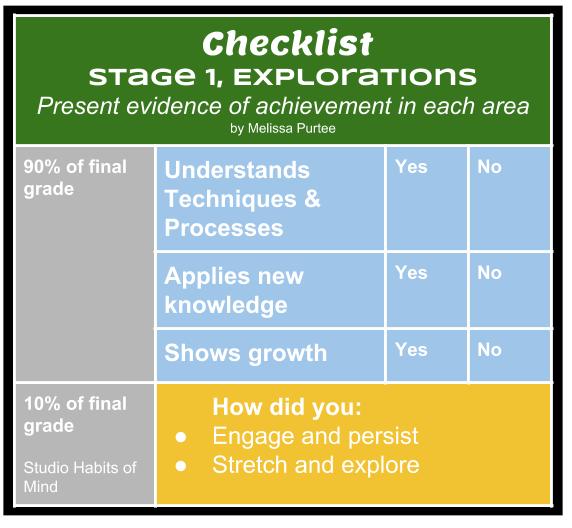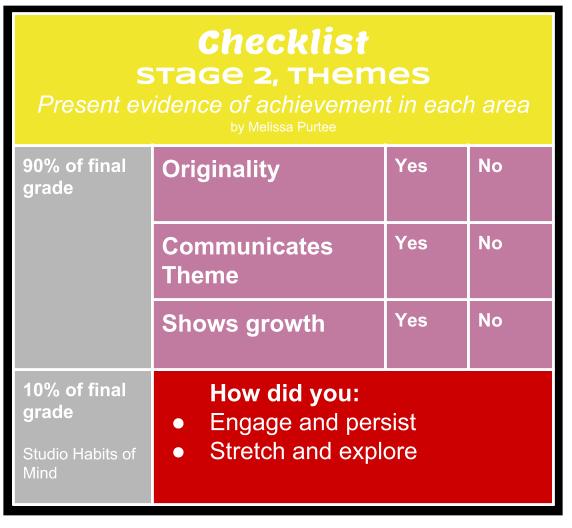|
Grading is a thing I think about - a lot. I've been thinking about how to grade students' art experience in a way that is meaningful and valuable to them since I started thinking about how to make TAB work at the high school level in 2013. I've tried lots of things that mostly involved minimizing and simplifying grading. There are lots of good ways to grade, as well as to teach, but simplifying grading did not work for me. When I simplified grading, giving all students who met expectation the same grade, it did not feel like I was recognizing or reinforcing their individual learning experiences. It made the grade feel arbitrary and worked against the intrinsic motivation I was trying to foster. Many kids figured out that if they finished some art and did their blog posts, they'd be fine. I didn't want students who stopped at "fine" - I wanted more. So this school year I've been thinking about how to personalize grading. Moving Away From Blog Posts.I like the idea of blog posts; students reflecting, putting their ideas in writing and compiling a digital portfolio. All great in theory, but less so in practice. There were two big drawbacks from blog posts that I noticed: - It was challenging for me to give kids the timely feedback they needed to clearly express their thoughts. - Due reading articles like this and this - about the negative impact technology has on children, I've been realizing that I want to be more intentional about how students use technology and increase face to face interaction. I plan to still have students create a digital portfolio, but they will spend a few weeks working on it at the end of the course, not posting weekly. In lieu of weekly blog posts, I've been grading through face-to-face conferences with students. Grading through conferences has helped me get know students on a deeper level and understand their work/ work process better. It's also given me an opportunity teach the thinking I often noticed was missing in student writing; how to use evidence to support claims about what they've learned. Three Stages of LearningThis year, I've separated my beginning class into three stages: Explorations, Themes and Portfolio. The focus of each stage is different, with end goal of all students able to use their studio to make the art they independently envision. I grade the work in each stage by conferencing with students, who are responsible for presenting evidence of meeting learning goals. The evidence they select includes finished artwork and development materials like sketches, research and experimentation. After we review the evidence if they haven't meet specific goals (and therefore have a lower grade), we problem solve, together, what they can do to meet them. Students can provide evidence for a higher grade at any time during the course, with no penalty. I talk with students about their work and process daily in informal conversation that happen during work time. Grading conferences are more formal and private. I sit at my desk and the student brings their work and evidence over. It's a bit removed from where the class is working and much easier to have a few uninterrupted minutes. What students learn and have to provide evidence of in each stage: Stage 1, Explorations. Students learn about a range of media and process through a combination of experimentation and self-directed work. Media is sleselected by me or is limited to a few options (example - acrylic or watercolor paint in the painting exploration) ATP is introduced and directly taught. Stage 2, Themes Students experience generating ideas, selecting media/ processes and developing concepts from thought to finished product through working with themes selected by me. Stage 3, Portfolio Students apply everything they've learned in this stage. They independently select a theme or learning goal for the focus of a collection of work. This work is posted to a digital portfolio, created with weebly, along with work that shows evidence of what they've learned during the class, with a focus of showing evidence of growth. So far, I'm noticing that the grades students and I arrive at through conferences feel both meaningful and personal. I find that the quality of evidence that supports students' claims about what they've learned is vastly improved by my ability to ask clarifying questions on the spot. When they are unable to provide evidence they understand where they fell short and know what to do to fix it.
Having this conversation face to face has been delightful for me. It's helped me understand where my students are in their learning and made it easy to provide individualised support. I'm also beginning to notice a shift in work ethic since I've started tying 10% of each grade to the Studio Habits of Engage & Persist and Stretch & Explore. Students have to persuade me that they've earned some or all of these extra points, which has resulted in lots of reflection of past and current studio practice. Overheard last week: Student 1 - That drawing looks good. Student 2- The face shapes not right. I'm redoing it. (Yelling) MS PURTEE I'M PERSISTING!
2 Comments
12/20/2018 11:08:52 am
I attached the rubric above that I've been using with my Art 1 students this year. They finish their project, then fill out the rubric and turn it in in Google Classroom. I read their reflections as they walk up to my desk, then we have a quick discussion as we look at their finished piece. We decide on a score, I record it in Classroom and they hang their piece on the display board. It is quick, easy, relatively painless and I never take up any work! (Thus never losing any of their work on the black hole of my work table...)
Reply
Amy
7/16/2019 01:54:31 pm
Lindsey,
Reply
Your comment will be posted after it is approved.
Leave a Reply. |
Mrs. PurteeI'm interested in creating a student student centered space for my high school students through choice and abundant opportunity for self expression. I'm also a writer for SchoolArts co-author of The Open Art Room. Archives
December 2019
Categories
All
|



 RSS Feed
RSS Feed
